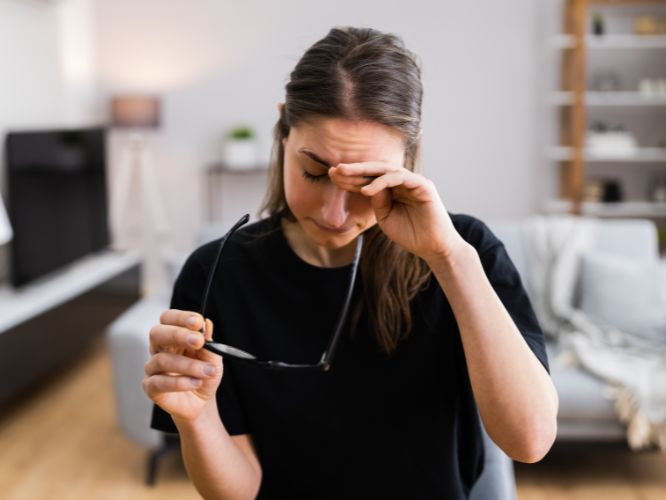
Managing dry, tired eyes has become a crucial aspect of maintaining overall eye health in our fast-paced digital age, where screens dominate our daily lives. The strain imposed by prolonged screen time, environmental factors, and lifestyle choices often leads to discomfort, redness, and fatigue in our eyes. Fortunately, adopting a proactive approach towards eye care can significantly alleviate these symptoms and promote better overall eye health.
Understanding the Causes
Dry and tired eyes can result from various factors, and identifying the root cause is essential for effective management. Prolonged screen exposure, inadequate blinking, environmental pollutants, and certain medical conditions can contribute to eye discomfort.
Factors such as ageing, hormonal changes, and specific medications may also exacerbate the symptoms. Recognising these triggers is the first step towards developing a targeted strategy for managing dry, tired eyes.
Follow the 20-20-20 Rule
One simple yet effective way to alleviate eye strain is by adhering to the 20-20-20 rule. For every 20 minutes of screen time, take a 20-second break and focus on an object 20 feet away. This practice helps reduce eye strain, minimises fatigue, and prevents long-term damage caused by continuous screen exposure.
To help integrate the 20-20-20 rule into your routine, consider using supportive technology. Apps like Eye Saver and Stretchly offer customizable reminders to rest your eyes and stretch your body. Browser extensions such as Protect Your Vision (PYV) and Take a Break by Eye Care Plus can seamlessly fit into your web browsing activities, reminding you to take timely breaks.
For desktop users, software like Time Out for Mac and Workrave (for Windows and Linux) are excellent tools for ensuring you adhere to the rule by locking your screen for breaks, making it easier to manage eye health amidst busy schedules.
Maintain Proper Lighting
Creating an eye-friendly environment involves adequate lighting. Position your screen to avoid glare and ensure that the room is well-lit. Natural light is ideal, but if that’s not possible, use artificial lighting that is evenly distributed to reduce eye strain.
Stay Hydrated
Dehydration can contribute to dry eyes, so staying adequately hydrated throughout the day is crucial. Drinking enough water supports overall health, including the lubrication of your eyes. Consider using a humidifier in dry environments to maintain optimal moisture levels.
Blink Regularly
Extended screen time often leads to reduced blinking, causing dry eyes. Make a conscious effort to blink regularly, as blinking helps distribute tears and moisturise the eyes. Consider using artificial tears or TheraTears hydrating eye drops to provide additional relief when necessary.
Adjust Screen Settings
Optimise your device settings to reduce eye strain. Adjust the brightness, contrast, and font size to ensure comfortable viewing. Additionally, consider using blue light filters or glasses to minimise the potential negative impact of screen-generated blue light on your eyes.
Get Adequate Sleep
Quality sleep is essential for overall health, including eye health. Lack of sleep can contribute to eye fatigue and dryness. Ensure you get 7-9 hours of uninterrupted sleep each night to allow your eyes to rest and rejuvenate.
Environmental Adjustments
While proper lighting is crucial for minimizing eye strain, other environmental factors play a significant role in maintaining eye health. Air quality and humidity levels, in particular, can profoundly impact those suffering from dry, tired eyes. Pollutants and allergens present in the environment can irritate the eyes, leading to increased discomfort and exacerbating dryness.
Here are some tips to make environmental adjustments that can support better eye health:
- Improve Indoor Air Quality: Use air purifiers to reduce the presence of airborne pollutants and allergens in your indoor environment. Choose a purifier with a HEPA filter for best results, as it can capture fine particles including pollen, dust, and pet dander, which are common irritants.
- Maintain Optimal Humidity Levels: Dry air can cause tears to evaporate more quickly, leaving the eyes feeling dry and uncomfortable. Using a humidifier, especially during winter months when indoor air tends to be drier, can help maintain moisture in the air and provide relief for dry eyes.
- Keep Your Environment Clean: Regularly cleaning surfaces, bedding, and air filters can reduce the accumulation of dust and allergens in your living and working spaces. Use a damp cloth for cleaning to avoid circulating dust into the air.
- Ventilate Your Space: Ensure adequate ventilation in your home and workspace to decrease the concentration of indoor pollutants. Open windows when possible to allow fresh air to circulate and reduce the accumulation of indoor pollutants.
- Reduce Exposure to Smoke: Smoke from cigarettes, fires, and cooking can irritate the eyes. Avoid smoking indoors and use exhaust fans in kitchens to remove cooking fumes. If you’re exposed to environmental smoke, using eye drops can help mitigate irritation.
Consult an Eye Care Professional
If symptoms persist or worsen, it’s crucial to consult with an eye care professional. They can conduct a comprehensive eye examination to identify underlying issues and provide tailored treatment recommendations.
Managing dry, tired eyes is a holistic process involving lifestyle adjustments and proactive eye care. By adopting healthy habits, incorporating regular breaks during screen time, and seeking professional advice, individuals can take charge of their eye health and enjoy improved overall well-being. Remember, caring for your eyes is an investment in long-term vision and a vital component of a healthier, more comfortable lifestyle.


